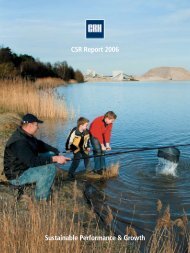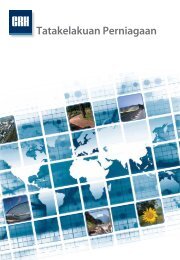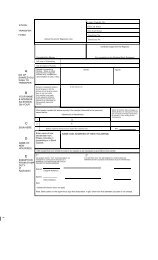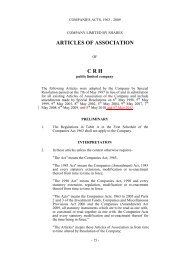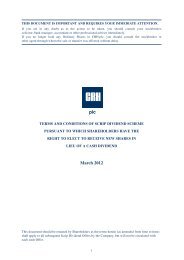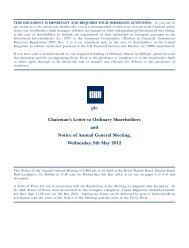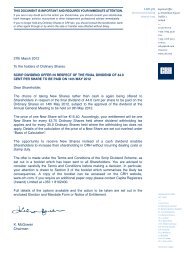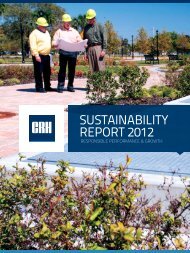2009 Annual Report - CRH
2009 Annual Report - CRH
2009 Annual Report - CRH
- TAGS
- annual
- www.crh.com
You also want an ePaper? Increase the reach of your titles
YUMPU automatically turns print PDFs into web optimized ePapers that Google loves.
Accounting Policies<br />
Statement of compliance<br />
The Consolidated Financial Statements of <strong>CRH</strong> plc have been prepared in<br />
accordance with International Financial <strong>Report</strong>ing Standards (IFRS) as adopted by<br />
the European Union, which comprise standards and interpretations approved by<br />
the International Accounting Standards Board (IASB). IFRS as adopted by the<br />
European Union differ in certain respects from IFRS as issued by the IASB.<br />
However, the Consolidated Financial Statements for the financial years presented<br />
would be no different had IFRS as issued by the IASB been applied. References<br />
to IFRS hereafter should be construed as references to IFRS as adopted by the<br />
European Union.<br />
<strong>CRH</strong> plc, the parent company, is a publicly traded limited company incorporated<br />
and domiciled in the Republic of Ireland.<br />
Basis of preparation<br />
The Consolidated Financial Statements, which are presented in euro millions, have<br />
been prepared under the historical cost convention as modified by the measurement<br />
at fair value of share-based payments, retirement benefit obligations and certain<br />
financial assets and liabilities including derivative financial instruments.<br />
The accounting policies set out below have been applied consistently by all the<br />
Group’s subsidiaries, joint ventures and associates to all periods presented in<br />
these Consolidated Financial Statements.<br />
The preparation of financial statements in conformity with IFRS requires the use of<br />
certain critical accounting estimates. In addition, it requires management to<br />
exercise judgement in the process of applying the Company’s accounting policies.<br />
The areas involving a high degree of judgement or complexity, or areas where<br />
assumptions and estimates are significant to the Consolidated Financial<br />
Statements, relate primarily to accounting for defined benefit pension schemes,<br />
provisions for liabilities, property, plant and equipment and goodwill impairment.<br />
The financial year-ends of the Group’s subsidiaries, joint ventures and associates<br />
are co-terminous.<br />
Adoption of IFRS and International Financial <strong>Report</strong>ing Interpretations<br />
Committee (IFRIC) Interpretations<br />
IFRS and IFRIC Interpretations adopted during the financial year<br />
The Group has adopted the following new and amended IFRS and IFRIC<br />
interpretations in respect of the <strong>2009</strong> financial year-end:<br />
– IFRS 2 Share-based Payment – Vesting Conditions and Cancellations effective<br />
1st January <strong>2009</strong><br />
– IFRS 7 Financial Instruments: Disclosures effective 1st January <strong>2009</strong><br />
– IFRS 8 Operating Segments effective 1st January <strong>2009</strong><br />
– IAS 1 Presentation of Financial Statements effective 1st January <strong>2009</strong><br />
– IAS 23 Borrowing Costs (Revised) effective 1st January <strong>2009</strong><br />
– Amendments to IAS 32 and IAS 1 – Puttable Financial Instruments and<br />
Obligations Arising on Liquidation effective 1st January <strong>2009</strong><br />
– IFRIC 9 Remeasurement of Embedded Derivatives and IAS 39 Financial<br />
Instruments: Recognition and Measurement effective 1st July 2008<br />
– IFRIC 13 Customer Loyalty Programmes effective 1st July 2008<br />
– IFRIC 15 Agreements for the Construction of Real Estate effective 1st January<br />
<strong>2009</strong><br />
– IFRIC 16 Hedges of a Net Investment in a Foreign Operation effective 1st<br />
October 2008<br />
– IFRIC 18 Transfers of Assets from Customers effective for transfers on or after<br />
1st July <strong>2009</strong><br />
– Improvements to IFRSs (May 2008) with an effective date of 1st January <strong>2009</strong><br />
(i.e. all except for IFRS 5 amendment)<br />
IFRS 8 Operating Segments replaced IAS 14 Segment <strong>Report</strong>ing. Following a<br />
review of its requirements, the Group has concluded that the operating segments<br />
determined in accordance with IFRS 8 are the same as the business segments<br />
previously identified under IAS 14. IFRS 8 disclosures are shown in note 1,<br />
including the related revised comparative information.<br />
IAS 1 Presentation of Financial Statements has been revised and now requires the<br />
separation of owner and non-owner changes in equity and the presentation of a<br />
66 <strong>CRH</strong><br />
statement of changes in equity as a primary statement (the information contained<br />
in this statement had previously been provided by the Group in the notes to the<br />
Consolidated Financial Statements). The statement of changes in equity includes<br />
only details of transactions with owners, with non-owner changes in equity<br />
presented in a reconciliation of each component of equity. The revised standard<br />
also introduces the statement of comprehensive income; it presents all items of<br />
recognised income and expense, either in one single statement, or two linked<br />
statements. The Group has elected to present two statements, the Consolidated<br />
Income Statement and the Consolidated Statement of Comprehensive Income<br />
(similar to the Statement of Recognised Income and Expense previously provided<br />
except that taxation relating to equity items is now shown within the Consolidated<br />
Statement of Changes in Equity).<br />
IFRS 7 Financial Instruments – Disclosures (amendment) requires enhanced<br />
disclosures about fair value measurement and liquidity risk and disclosure of fair<br />
value measurements by level of a fair value measurement hierarchy. The changes<br />
required by the amended standard are purely disclosure-related.<br />
Adoption of the remaining standards and interpretations did not result in material<br />
changes in the Group’s financial statements.<br />
IFRS and IFRIC Interpretations which are not yet effective<br />
The Group has not applied the following standards and interpretations that have<br />
been issued but are not yet effective:<br />
– IFRS 2 Share-based Payment: Group Cash-settled Share-based Payment<br />
Transactions effective 1st January 2010<br />
– IFRS 3R Business Combinations (Revised) and IAS 27 Consolidated and<br />
Separate Financial Statements (Amended) effective 1st July <strong>2009</strong> including<br />
consequential amendments to IFRS 7, IAS 21, IAS 28, IAS 31 and IAS 39<br />
– IAS 39 Financial Instruments: Recognition and Measurement – Eligible Hedged<br />
Items effective 1st July <strong>2009</strong><br />
– IFRIC 17 Distributions of Non-cash Assets to Owners effective 1st July <strong>2009</strong><br />
– Improvements to IFRSs (April <strong>2009</strong>) – amendments applying in respect of 2010<br />
financial year-ends and thereafter<br />
The standards and interpretations addressed above will be applied for the<br />
purposes of the Group financial statements with effect from the dates listed.<br />
IFRS 3R Business Combinations, while it continues to apply the acquisition<br />
method to business combinations, introduces a number of changes to the<br />
accounting for business combinations that will impact the amount of goodwill<br />
recognised, the reported results in the period that an acquisition occurs and future<br />
reported results. These changes will include, but will not be limited to, the<br />
expensing of acquisition-related costs as incurred, the method of accounting for<br />
step acquisitions and the recognition and measurement of contingent consideration.<br />
IAS 27 (Amended) requires that a change in the ownership interest of a subsidiary<br />
(without loss of control) is accounted for as an equity transaction. The Group will<br />
apply IFRS 3R prospectively to all business combinations from 1st January 2010.<br />
The application of the other standards and interpretations is not envisaged to have<br />
any material impact on the Group financial statements.<br />
Basis of consolidation<br />
The Consolidated Financial Statements include the financial statements of the<br />
Parent Company and all subsidiaries, joint ventures and associates, drawn up to<br />
31st December each year.<br />
Subsidiaries<br />
The financial statements of subsidiaries are included in the Consolidated Financial<br />
Statements from the date on which control over the operating and financial<br />
decisions is obtained and cease to be consolidated from the date on which control<br />
is transferred out of the Group. Control exists when the Group has the power,<br />
directly or indirectly, to govern the financial and operating policies of an entity so<br />
as to obtain economic benefits from its activities. The existence and effect of<br />
potential voting rights that are currently exercisable or convertible are considered<br />
in determining the existence or otherwise of control.<br />
Joint ventures<br />
In line with IAS 31 Interests in Joint Ventures, the Group’s share of results and net<br />
assets of joint ventures (jointly controlled entities), which are entities in which the<br />
Group holds an interest on a long-term basis and which are jointly controlled by





